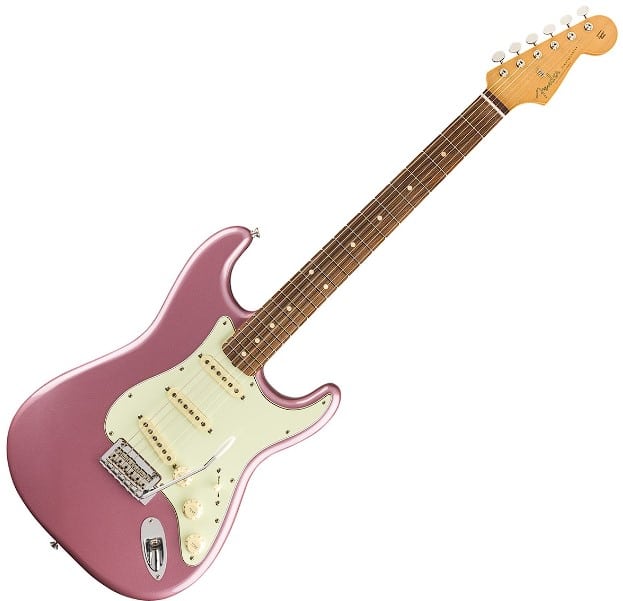Don’t let your guitar-playing dreams resemble a cat wrestling a snake. Discover the 8 most common mistakes guitarists make and the simple fixes that can turn you from a wannabe musician into an absolute rockstar.

With tips to spare your fingers from needless agony and your neighbor’s ears from surprise concerts, prepare to rock your way to guitar greatness! Just remember, practice makes perfect (or at least less cringe-worthy).
Fretting About Frets: Proper Finger Placement

Proper finger placement is critical for playing the electric guitar smoothly and effectively. With it, beginners can avoid issues like string buzz and clumsy chord transitions. Let’s explore these problems and how to tackle them head-on.
Avoiding the Dreaded String Buzz

Ah, the dreaded string buzz—that annoying, wasp-like drone that makes your guitar sound like it’s having a mid-life crisis.
Always place your finger slightly behind the fret to avoid this common issue, not directly on top of it.
Pressing too hard can also cause buzzing or serious hand cramps, so finesse is key. Curving your fingers naturally and perpendicularly hitting the strings with your fingertips keeps everything crisp and clear.
The Art of Clean Chord Transitions

Transitioning between chords can be challenging, but proper finger placement is key. Place your fingers firmly on the strings, close to the frets, to avoid buzzing sounds.
Practice moving between chords slowly, focusing on precise finger placement. Keep your fingertips perpendicular to the strings for smoother transitions.
Your fingers should feel comfortable, not strained. With these tips, you’ll minimize pauses and make your chord changes sound clean and seamless.
Pick Problems: Mastering the Plectrum

Use a balanced grip that’s not too tight or loose when holding a pick. Place the pick between your thumb and index finger, resting it against the side of your index finger’s first joint.
With your thumb gently curled over the top, it should stick out just enough to hit the strings. Gripping the pick too tightly can cause soreness and limit smooth movement while holding it too loosely can cause it to slip out of your hand frequently.
Try practicing with different grip pressures for a week to find the perfect balance that works for you.
Strumming Shenanigans: Consistency is Key

The key to smooth strumming is consistency. New players often expose too much of the pick, causing their strumming to sound erratic. Instead, expose only enough of the pick’s tip to touch the strings.
Another common issue is uneven strumming, which happens when your arm moves but your wrist remains stiff. Engage your wrist and synchronize its movement with your arm to create smoother, more rhythmic strums.
A metronome can also help maintain a steady tempo and improve your strumming technique. You’ll avoid common picking problems and play like a pro by mastering this method
Amplification Struggles: Volume Control

When it comes to volume, more isn’t always better—unless deafening the neighbors is your goal. Cranking the gain too high can lead to a distorted mush. It’s a common rookie mistake, yet easily fixed.
If you’re using a tube amp, be gentle with the gain. Tube amps have a sweet spot; finding it is key to getting the best sound without entering fuzz territory.
Tone Tweaking

Finding the perfect tone can be challenging. The right mix of treble, mids, and bass is crucial. Treble adds brightness and clarity but use it sparingly.
Set mid frequencies around 5 or 6 for balance. Too much bass can muddy your sound, while too little can make it tinny.
Experiment with your pedal order as well. Placing distortion pedals before or after the preamp can dramatically change your tone. Try different combinations, and you might discover your unique sound.
String Changing Maintenance

Changing guitar strings is a ritual that keeps your instrument sounding its best. Depending on how often you play, replace strings every 1-3 months.
Gigging musicians may change them weekly. For a faster, neater job, use a string winder and wire cutters.
Always stretch new strings by tuning up, gently pulling each string, and re-tuning. Repeat this process a few times to prevent strings from going flat during a performance.
Avoid twisting the string around the tuning peg too often, as it can affect tuning stability. Aim for 2-3 neat winds at most.
Perfect Practice Makes Perfectly Amusing

We’ve all experienced the excitement of strumming away, only to realize we’re making typical beginner mistakes. By steering clear of these common errors and developing good habits, any guitarist can make significant progress.
- Avoiding poor posture: Keep that back straight.
- Keeping time: Metronomes are your new best friends.
- Sensible string attacks: No more wrestling those strings.
- Overzealous finger pressure: Relax those fingertips.
- Flying fingers: Keep them grounded.
- Wrist angles: Avoid awkward bends.
Remember, practice is key to improving your skills. So grab your guitar and start jamming! And no, air guitar doesn’t count!
Our 3 Recommended Electric Guitar
Fender Vintera 60s Mod Stratocaster PF, Burgundy Mist

FEATURES: Fingerboard Material: Pau Ferro
OTHER INFO: Deluxe Gig Bag included
- Genuine representation of the era's rock sound.
- Visually appealing Pau Ferro fingerboard.
- Indicates good quality control and attention to detail in shipping.
- Praises smooth and responsive playability.
- Professional Setup
- Slightly higher price point
- Limited color options
When you click ‘Check Price’, you’ll see there are loads of great places to buy this item. Our personal favorite is Sweetwater for the US, and Thomann and Gear4Music for the UK & Europe.
They are the largest music retailers, with excellent customer service, competitive prices, really fast shipping, and the longest guarantees.
The professional musician who wrote this article combined many things,
from the product build, manufacturer’s reputation through to feedback
from other users, to create our famous TedScore™.
Fender Player Plus Stratocaster HSS PF, Silverburst

FEATURES:
- Comfort-contoured alder body with figured maple top.
- Modern C-shaped neck
- Chrome hardware for solid durability.
- The Tremolo arm doesn't stay in place after prolonged use.
When you click ‘Check Price’, you’ll see there are loads of great places to buy this item. Our personal favorite is Sweetwater for the US, and Thomann and Gear4Music for the UK & Europe.
They are the largest music retailers, with excellent customer service, competitive prices, really fast shipping, and the longest guarantees.
The professional musician who wrote this article combined many things,
from the product build, manufacturer’s reputation through to feedback
from other users, to create our famous TedScore™.
Gretsch G5420T Electromatic Single-Cut with Bigsby, Airline Silver

FEATURES:
- Dazzling vintage-inspired design.
- Crystal-clear retro electric guitar sound.
- Solid construction and smooth playability.
- It is challenging to adjust the bridge, especially during string changes.
When you click ‘Check Price’, you’ll see there are loads of great places to buy this item. Our personal favorite is Sweetwater for the US, and Thomann and Gear4Music for the UK & Europe.
They are the largest music retailers, with excellent customer service, competitive prices, really fast shipping, and the longest guarantees.
The professional musician who wrote this article combined many things,
from the product build, manufacturer’s reputation through to feedback
from other users, to create our famous TedScore™.













Regarding amplification struggles and volume control mentioned by Lewis Turner, it is crucial to highlight the importance of understanding the signal chain in electronic devices. Adjusting volume isn’t solely about the amplifier’s volume knob but also involves the guitar’s volume and tone controls, the effect pedals (if any are in use), and even the type and quality of cables connecting these components. Each of these can significantly affect the overall sound output, and knowing how to manipulate each element can lead to a much more satisfactory and controlled sound production.
Tara_the_Tuner, absolutely spot on about signal chain importance. It’s a game changer for sound.
Thanks, SoundWaveSteve! It’s all about knowing your equipment and how to use it effectively.
Interesting points on fretting and finger placement, but I think there’s more to discuss regarding the impact of different fret materials and sizes on playability and tone. While the basics are covered, the nuances of fret composition could provide readers with more comprehensive insights for a truly optimized playing experience.
hey, any advice on mastering the plectrum for faster genres? I’m trying to upgrade my pick game but it’s tricky to get it right.
Try experimenting with different thicknesses, Lexi88. It really helps with control and speed.
just got into changing my guitar strings and it’s like a whole new world. thanks for the tips, definitely noticing a difference in sound.